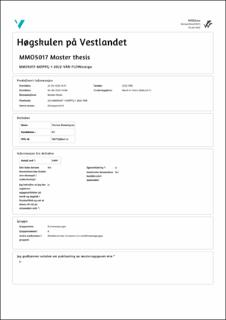| dc.description.abstract | On the Norwegian Continental Shelf there are over 5 000 well paths drilled for the extraction of oil and gas. Before the Norwegian oil and gas adventure could be brought to an end, all of these well paths would need to be permanently plugged and abandoned. With a typical time estimate for PP&A from 2015, it would take 15 semisubmersibles approximately 20-years to perform the operation on the established wells, not including any wells drilled after 2015 (Energi24, 2022). There are also technical difficulties involved with PP&A on the NCS. The wells waiting for PP&A have been drilled over a long period of time, and the development of the BOPs used today, has been a constant ongoing process. Therefore, it is natural that there are wellheads that will not sustain the forces applied from connecting a typical BOP used in 2022. The dimensional forces are the weight of the BOP, acting downwards on the wellhead, and the bending moment, caused by drag forces, or misalignment between the wellhead centre axis and the rig/vessels centre axis.
This gives the background for the research question for this thesis: “How to ensure satisfying well control, at a low cost when performing permanent plug and abandonment operations on subsea controlled oil and gas wells, located on the Norwegian continental shelf, where the wellhead is not designed to withstand the forces applied by connecting a typical blow out preventer used today?”
To investigate this issue it has been performed a literature study, to determine the laws and regulations surrounding well control during PP&A operations, and it has been performed interviews of different informants with key information from different backgrounds. The data collected through these methods has been used to evaluate several difference ideas, these are presented in Chapter 5, and the evaluation is presented in chapter 7.
From the evaluation of ideas, the idea of using existing components to create a smaller blow out preventer (BOP), also called a Subsea Shut of Devise (SSD) is concluded to be the most favourable method included in this research project. For the remaining part of this report, it is looked into optimising the SSD in regard to weight. It is concluded that the SSD should be designed after the ISO 13628-7 standard. This standard requires one bi-directional isolation valve, also known as an Annular BOP, and doble shearing valve or ram BOP. Based on this it is concluded that the main components from the bottom should be: a wellhead connector, one shear ram, one shear seal ram, one annular, and one mandrel or customer specific component as a top connection.
With regards to the comparison of components it is concluded that the following components would be the most weight efficient for the main components, for the wellhead connector Oilstates Lynxgrip 15/30 connector is preferred, for the BOP a Hydril 15k double ram BOP with one 15” and one 22” bonnet is preferred, for the annular BOP a Cameron 18-3/4” 10k DL is preferred. This report does not conclude on which components that are optimal for top connection, and fail-safe valves. Some of these will be depending on customer specifications or the components that should be connected with the SSD. For the framework of the SSD, it will not be given a conclusion of the design, as this is too early in the design process.
Through this report, it has been discussed if the pressure rating of the ram BOP needs to be 15k, or if it could be changed to 10 or 5k. The possibility of using a BOP with a pressure rating lower than 15k should diffidently be present, as the numbers of wells, where the well pressure exceeds 15k are considered to be in the minority of wells on the NCS. It has also been discussed if it is possible to class up a 10k BOP to be used on a 15k well, by implementing measurements for improved inspection and surveillance. In this report, it is concluded that a solution like this would work, as long as the developer finds a manufacturer who is willing to agree. The fact that the OEM most likely must be included in the process, makes this the most important argument for which BOP that should be used. Therefore, it is not performed a thorough comparison of the weight of different 10k ram BOPs
It is concluded that there is a large possibility to offer a more cost-efficient method for PP&A operations, by using an SSD and an LWI vessel instead of a semisubmersible. It has also been discussed how the business module should be for a company developing an SSD. But it has not been performed a thorough enough consideration in this report to have a valid conclusion on this question. From a simple CO2 calculation presented in chapter 9.5, it can be concluded that it gives the indication that performing the PP&A operation with an SSD and LWI vessel should lead to lower emissions that performing the operation with a semisubmersible. | en_US |

